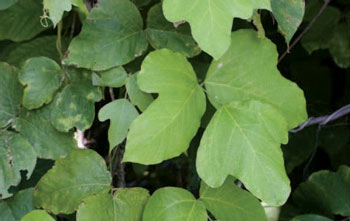Kudzu
What you need to know about kudzu. Includes habitat, identifying features and what you can do to reduce its impact.
Kudzu is a perennial climbing vine native to eastern Asia that was recently found in Leamington, Ontario. The plant was first brought to North America in 1876 to landscape a garden at the United States Centennial Exposition in Philadelphia, Pennsylvania. Its use was later encouraged for livestock forage, erosion control and ornamental use, which led to it being widely planted in the southeastern United States.

Kudzu leaves and flowers. Photo: Rachel Gagnon, OIPC
Kudzu can grow amazingly fast – up to 30 centimetres a day and up to 30 metres a season in the southeastern United States. Its massive tap roots can weigh more than 45 kilograms, with up to 30 vines growing from a single root crown. It establishes very quickly, and aggressively invades open areas, forest edges and agricultural fields. Kudzu is expanding its range northward into Ontario.
Range
Outside its native range, kudzu has been widely introduced to the eastern United States and is found from New York to Florida, and as far west as Texas. The most extensive infestations have been found in the southern United States, including Mississippi, Alabama and Georgia, earning kudzu the nickname “the vine that ate the south.” In 2009, a local ecologist discovered the only known population of kudzu in Canada on a hillside near Leamington, Ontario, on the north shore of Lake Erie.
Impacts of kudzu
Kudzu’s aggressive nature and ability to grow in a wide range of conditions can damage a variety of plants, ecosystems and structures.
- The fast-growing vine can kill trees or shrubs by cutting off nutrient supplies, weighing down a tree or shrub until it breaks, or casting dense shade.
- Kudzu reduces plant biodiversity by eliminating competing vegetation, including native species.
- The vine can host Asian soybean rust, a fungus that infects soybeans and other members of the pea family.
- Its rapid growth allows it to blanket trees, fences, houses and road signs. Heavy kudzu growth on hydro poles has caused power outages.

Invasion of kudzu near Leamington, Ontario, on the shores of Lake Erie. Photo: Sam Brinker, MNR
How to identify kudzu
- Leaves grow alternately on the stem, with three broad leaflets per leaf, each seven to 25 centimetres long.
- Young stems are yellow-green. Mature stems can reach up to 10 centimetres in diameter and are dark brown and woody, with white pits in the bark.
- Flowers are purple, grow in long hanging clusters and are highly fragrant.
- Seeds grow in clusters of brown, flattened pods that are five to nine centimetres long.
Kudzu resembles the native species hog-peanut (Amphicarpea bracteata), but hog-peanut only grows to 1.5 metres and has paler violet or white flowers. Kudzu may also be mistaken for riverbank grape (Vitis riparia), a native species that is able to climb trees but has shredded bark and coarsely toothed leaves with no leaflets.
What you can do
- Learn how to identify kudzu and other invasive plants. If you see kudzu growing in Ontario, please call the Invading Species Hotline at
1-800-563-7711 or visit Ontario's invading species awareness program to report a sighting. - Avoid using invasive plants in gardens and landscaping.
- Buy native or non-invasive plants from reputable garden suppliers. Native plants provide habitat and food sources for native wildlife. See Grow Me Instead: Beautiful Non-Invasive Plants for Your Garden. Go to Stop the spread of invasive species.
- Dispose of invasive plants in the garbage. Do not put them in the compost or discard them in natural areas. Discarded flowers may produce seeds.
- When hiking, prevent the spread of invasive plants by staying on trails and keeping pets on a leash.
Other resources:
- Invasive species centre
- Invasive species in Ontario
- Ontario invasive plants council
- Ontario's invading species awareness program
For more information:
Please contact the Invading Species Hotline at

Kudzu leaves. Photo: Rachel Gagnon, OIPC
This fact sheet may be reproduced for non-commercial purposes. © 2012
Cette publication est également disponible en français.